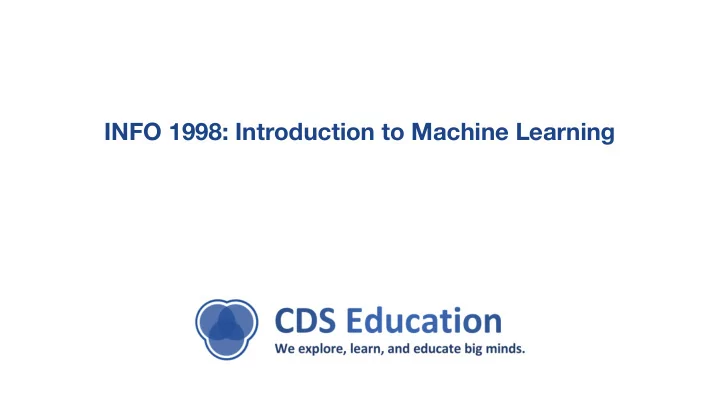

INFO 1998: Introduction to Machine Learning
Lecture 9: Clustering and Unsupervised Learning INFO 1998: Introduction to Machine Learning “If intelligence was a cake, unsupervised learning would be the cake, supervised learning would be the icing on the cake, and reinforcement learning would be the cherry on the cake. ” Yan Lecun, Facebook Director of AI research
Recap: Supervised Learning The training data you feed into your algorithm includes desired solutions ● Two types you’ve seen so far: regressors and classifiers ● In both cases, there are definitive “answers” to learn from ● Example 2: Classifier Example 1: Regressor Predicts label Predicts value
Recap: Supervised Learning Supervised learning algorithms we have covered so far: k-Nearest Neighbors ● Perceptron ● Linear Regression ● Logistic Regression ● Support Vector Machines ● Decision Trees and Random Forest ●
What’s the main underlying limitation of supervised learning?
Today: Unsupervised Learning In unsupervised learning, the training data is unlabeled ● Algorithm tries to learn by itself ● An Example: Clustering
Unsupervised Learning Some types of unsupervised learning problems: Clustering 1 k-Means, Hierarchical Cluster Analysis (HCA), Gaussian Mixture Models (GMMs), etc. Dimensionality Reduction 2 Principal Component Analysis (PCA), Locally Linear Embedding (LLE) Association Rule Learning 3 Apriori, Eclat, Market Basket Analysis More …
Unsupervised Learning Some types of unsupervised learning problems: Clustering 1 k-Means, Hierarchical Cluster Analysis (HCA), Gaussian Mixture Models (GMMs), etc. Dimensionality Reduction 2 Principal Component Analysis (PCA), Locally Linear Embedding (LLE) Association Rule Learning 3 Apriori, Eclat, Market Basket Analysis More …
Cluster Analysis
Cluster Analysis Loose definition: Clusters have objects which are “similar in some way” (and ● “dissimilar to objects in other clusters) Clusters are latent variables ● Understanding clusters can: ● - Yield underlying trends in data - Supply useful parameters for predictive analysis - Challenge boundaries for pre-defined classes and variables
Why Cluster Analysis? Real life example: Recommender Systems A Bunch of Cool Logos
Running Example: Recommender Systems Use 1: Collaborative Filtering “People similar to you also liked X” ● Use other’s rating to suggest content ● Pros Cons If cluster behavior is clear, Computationally expensive can yield good insights Can lead to dominance of certain groups in predictions
Running Example: Recommend MOVIES +
Running Example: Recommender Systems Use 2: Content filtering “Content similar to what YOU are viewing” ● Use user’s watch history to suggest content ● Pros Cons Recommendations made by Limited in scope and applicability learner are intuitive Scalable
Another Example: Cambridge Analytica Uses Facebook profiles to build psychological profiles, ● then use traits for target advertising Ex. has personality test measuring openness, ● conscientiousness, extroversion, agreeableness and neuroticism -> different types of ads
How do we actually perform this “cluster analysis”?
Popular Clustering Algorithms Hierarchical Gaussian k-Means Cluster Analysis Mixture Models Clustering (HCA) (GMMs)
Defining ‘Similarity’ How do we calculate proximity of different datapoints? ● Euclidean distance: ● Other distance measures: ● Squared euclidean distance, manhattan distance ○
Algorithm 1: Hierarchical Clustering Two types: Agglomerative Clustering ● Creates a tree of ○ increasingly large clusters (Bottom-up) Divisive Hierarchical Clustering ● Creates a tree of ○ increasingly small clusters (Top-down)
Agglomerative Clustering Algorithm Steps: ● - Start with each point in its own cluster - Unite adjacent clusters together - Repeat Creates a tree of increasingly large ● clusters
Agglomerative Clustering Algorithm How do we visualize clustering? Using dendrograms Each width represents distance between ● clusters before joining Useful for estimating how many clusters ● you have The iris dataset that we all love
Demo 1
Popular Clustering Algorithms Hierarchical Gaussian k-Means Cluster Analysis Mixture Models Clustering (HCA) (GMMs)
Algorithm 2: k-Means Clustering Input parameter: k Starts with k random centroids ➢ Cluster points by calculating distance ➢ for each point from centroids Take average of clustered points ➢ Use as new centroids ➢ Repeat until convergence ➢ Interactive Demo : http://stanford.edu/class/ee103/visualizations/kmeans/kmeans.html
Algorithm 2: k-Means Clustering A greedy algorithm ● Disadvantages: ● Initial means are randomly selected which can cause suboptimal partitions ○ Possible Solution : Try a number of different starting points Depends on the value of k ○
Demo 2
Coming Up Assignment 9 : Due at 5:30pm on May 6th, 2020 • Last Lecture : Real-world applications of machine learning ( May 6th, 2020 ) • Final Project Proposal Feedback Released • Final Project: Due on May 13th, 2020 •
Recommend
More recommend